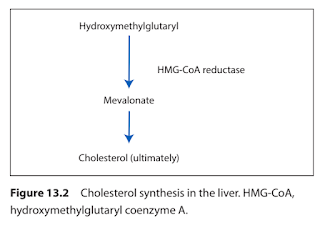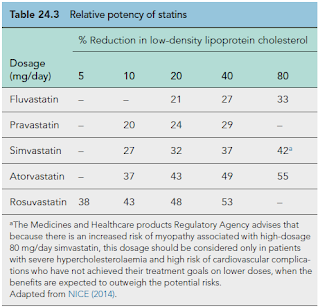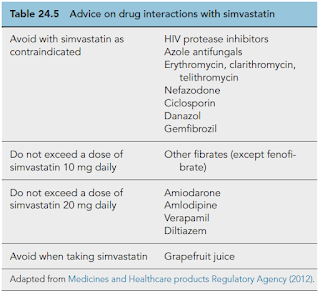Statins
Introduction
Statins are widely recognized as the first-line lipid-modifying therapy for reducing cardiovascular risk due to consistent results of numerous randomized primary and secondary prevention clinical trials.
- They achieve this by inhibiting the hydroxymethylglutaryl coenzyme A reductase (HMG-CoA reductase), which catalyses the first committed step of cholesterol synthesis in the liver.
- Statins are hepatoselective with extensive first-pass metabolism, which is advantageous because the liver is the main site of cholesterol synthesis, with extrahepatic sites synthesising essential cholesterol.
NOTE: There is growing interest in their potential pleiotropic effects, which are actions unrelated or indirectly related to their effect on plasma LDL levels, such as anti-infammatory and antioxidant effects.
Administration Time
When advising patients on statin use, it is commonly recommended to take statins at night.
- However, this statement may not apply universally to all statins available on the market.
- It serves as a simplified way of remembering the dosing time and subsequently, improving patient adherence.
- On the other hands, long-acting statins, such as rosuvastatin and atorvastatin, can be taken at any time of the day due to their extended duration of action.
Statin Choices
The selection of the most appropriate statin is still a subject of debate.
- Atorvastatin is currently favoured due to its low cost, safety profile and evidence of efficacy.
- Rosuvastatin, the most potent statin available, is normally reserved for individuals who have not responded adequately to their first-line statin or failure to tolerate other statins.
The degree of LDL-C reduction seen with the different statins is dose-dependent.
- High-intensity statin therapy produces a greater percentage LDL-C reduction and thus reduces CV events more than moderate-intensity statin therapy.
- Lower-intensity statin therapy has also been shown to reduce CV events, but to a lesser degree.
- Also, there is considerable inter-individual variation in LDL-C reduction with the same dose of drug.
NOTE: The FDA recommends rosuvastatin dosage reductions in Asian patients to maximum 20 mg daily because pharmacokinetic studies have demonstrated an approximate two-fold increase in median exposure to rosuvastatin in Asian subjects when compared to Caucasian controls.
Adverse effects
Many side effects appear mild and transient.
- The commonest include gastrointestinal symptoms, altered liver function tests and muscle aches.
Although rare, myopathy, characterized by unexplained muscle soreness or weakness, can occur with any statin and may lead to myoglobinuria secondary to rhabdomyolysis.
- Patients should seek medical advice once experiencing any muscle pain, tenderness or weakness.
NOTE: Muscle toxicity can occur with all statins, but the likelihood increases with higher doses (especially with high-dosage 80 mg/day simvastatin) and in certain patients.
Pregnancy
Statin therapy should be avoided in pregnancy and lactation unless there is strong clinical indication.
- It should not be prescribed to women of childbearing potential unless adequate contraception is taken.
Stopping Statins?
A common scenario encountered when dispensing statins is patients discontinuing their medication out of fear or side effects or the belief that their cholesterol levels are not significantly elevated.
- If LDL-C targets have been achieved, the same dose of statin should be maintained.
- Also, maximum tolerated doses of statins are recommended for patients who have experienced acute coronary syndrome to prevent major adverse cardiovascular events (MACEs), regardless of their cholesterol levels.
Co-enzyme Q10 Supplementation
A meta-analysis of 6 RCTs demonstrated that statin treatment is associated with significant reductions in plasma CoQ10 concentrations.
- Although CoQ10 deficiency has been associated with various conditions and disorders, the consequences of reduced CoQ10 levels in individuals following statin treatment remain unclear.
As CoQ10 deficiency has been associated with myopathies, multiple studies have investigated whether CoQ10 supplementation can improve muscle symptoms associated with statin use.
- To date, there have been mixed results across trials on the effect of CoQ10 supplementation on muscle symptoms in patients in taking statins.
However, if a patient chooses to take CoQ10, this supplement should be used with caution in those taking oral anticoagulants such as warfarin due to potential for interactions, and international normalised ratio (INR) should be monitored.
Drug Interactions
It is essential to be aware of potential drug interactions with statins, particularly with simvastatin.
External Links
- FDA Restricts Use of Simvastatin 80 mg, 2011
- Statin therapy and plasma coenzyme Q10 concentrations--A systematic review and meta-analysis of placebo-controlled trials, 2015
- The optimal time of day for statin administration: a review of current evidence, 2018
- Rosuvastatin pharmacokinetics in Asian and White subjects wild-type for both OATP1B1 and BCRP under control and inhibited conditions, 2017
- Can co-enzyme Q10 supplementation prevent or treat statin-associated muscle symptoms?, 2021






Comments
Post a Comment